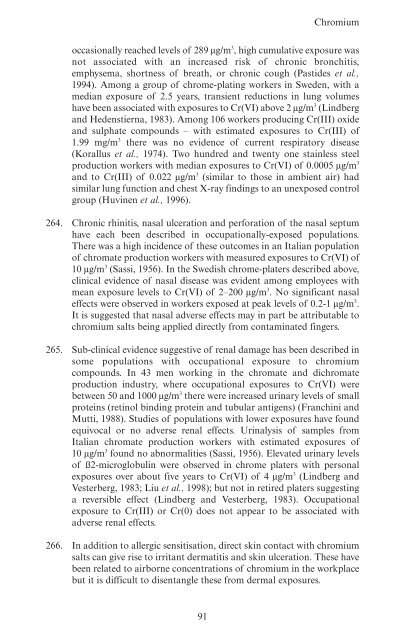Guidelines for Metals and Metalloids in Ambient ... - ARCHIVE: Defra
Guidelines for Metals and Metalloids in Ambient ... - ARCHIVE: Defra
Guidelines for Metals and Metalloids in Ambient ... - ARCHIVE: Defra
You also want an ePaper? Increase the reach of your titles
YUMPU automatically turns print PDFs into web optimized ePapers that Google loves.
Chromium<br />
occasionally reached levels of 289 µg/m 3 , high cumulative exposure was<br />
not associated with an <strong>in</strong>creased risk of chronic bronchitis,<br />
emphysema, shortness of breath, or chronic cough (Pastides et al.,<br />
1994). Among a group of chrome-plat<strong>in</strong>g workers <strong>in</strong> Sweden, with a<br />
median exposure of 2.5 years, transient reductions <strong>in</strong> lung volumes<br />
have been associated with exposures to Cr(VI) above 2 µg/m 3 (L<strong>in</strong>dberg<br />
<strong>and</strong> Hedenstierna, 1983). Among 106 workers produc<strong>in</strong>g Cr(III) oxide<br />
<strong>and</strong> sulphate compounds – with estimated exposures to Cr(III) of<br />
1.99 mg/m 3 there was no evidence of current respiratory disease<br />
(Korallus et al., 1974). Two hundred <strong>and</strong> twenty one sta<strong>in</strong>less steel<br />
production workers with median exposures to Cr(VI) of 0.0005 µg/m 3<br />
<strong>and</strong> to Cr(III) of 0.022 µg/m 3 (similar to those <strong>in</strong> ambient air) had<br />
similar lung function <strong>and</strong> chest X-ray f<strong>in</strong>d<strong>in</strong>gs to an unexposed control<br />
group (Huv<strong>in</strong>en et al., 1996).<br />
264. Chronic rh<strong>in</strong>itis, nasal ulceration <strong>and</strong> per<strong>for</strong>ation of the nasal septum<br />
have each been described <strong>in</strong> occupationally-exposed populations.<br />
There was a high <strong>in</strong>cidence of these outcomes <strong>in</strong> an Italian population<br />
of chromate production workers with measured exposures to Cr(VI) of<br />
10 µg/m 3 (Sassi, 1956). In the Swedish chrome-platers described above,<br />
cl<strong>in</strong>ical evidence of nasal disease was evident among employees with<br />
mean exposure levels to Cr(VI) of 2–200 µg/m 3 . No significant nasal<br />
effects were observed <strong>in</strong> workers exposed at peak levels of 0.2-1 µg/m 3 .<br />
It is suggested that nasal adverse effects may <strong>in</strong> part be attributable to<br />
chromium salts be<strong>in</strong>g applied directly from contam<strong>in</strong>ated f<strong>in</strong>gers.<br />
265. Sub-cl<strong>in</strong>ical evidence suggestive of renal damage has been described <strong>in</strong><br />
some populations with occupational exposure to chromium<br />
compounds. In 43 men work<strong>in</strong>g <strong>in</strong> the chromate <strong>and</strong> dichromate<br />
production <strong>in</strong>dustry, where occupational exposures to Cr(VI) were<br />
between 50 <strong>and</strong> 1000 µg/m 3 there were <strong>in</strong>creased ur<strong>in</strong>ary levels of small<br />
prote<strong>in</strong>s (ret<strong>in</strong>ol b<strong>in</strong>d<strong>in</strong>g prote<strong>in</strong> <strong>and</strong> tubular antigens) (Franch<strong>in</strong>i <strong>and</strong><br />
Mutti, 1988). Studies of populations with lower exposures have found<br />
equivocal or no adverse renal effects. Ur<strong>in</strong>alysis of samples from<br />
Italian chromate production workers with estimated exposures of<br />
10 µg/m 3 found no abnormalities (Sassi, 1956). Elevated ur<strong>in</strong>ary levels<br />
of ß2-microglobul<strong>in</strong> were observed <strong>in</strong> chrome platers with personal<br />
exposures over about five years to Cr(VI) of 4 µg/m 3 (L<strong>in</strong>dberg <strong>and</strong><br />
Vesterberg, 1983; Liu et al., 1998); but not <strong>in</strong> retired platers suggest<strong>in</strong>g<br />
a reversible effect (L<strong>in</strong>dberg <strong>and</strong> Vesterberg, 1983). Occupational<br />
exposure to Cr(III) or Cr(0) does not appear to be associated with<br />
adverse renal effects.<br />
266. In addition to allergic sensitisation, direct sk<strong>in</strong> contact with chromium<br />
salts can give rise to irritant dermatitis <strong>and</strong> sk<strong>in</strong> ulceration. These have<br />
been related to airborne concentrations of chromium <strong>in</strong> the workplace<br />
but it is difficult to disentangle these from dermal exposures.<br />
91
















